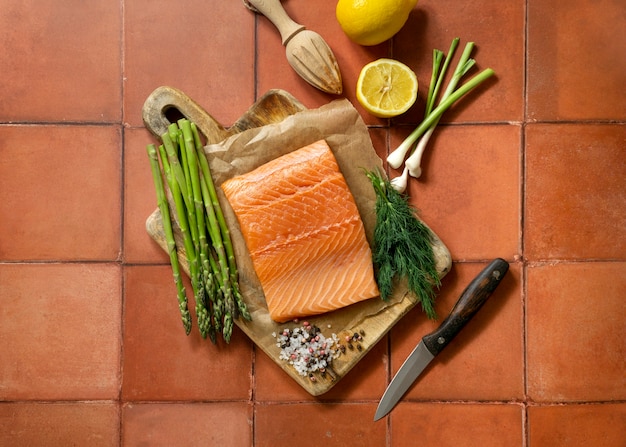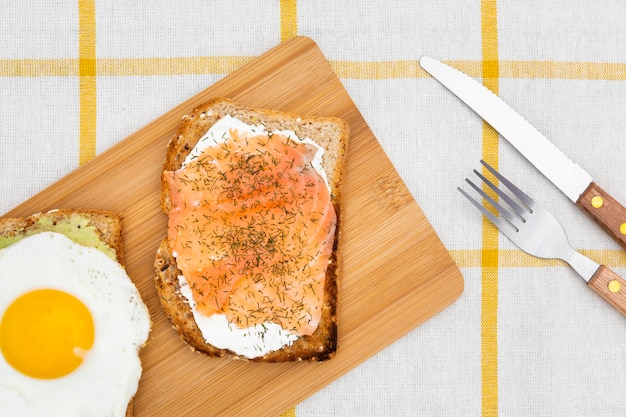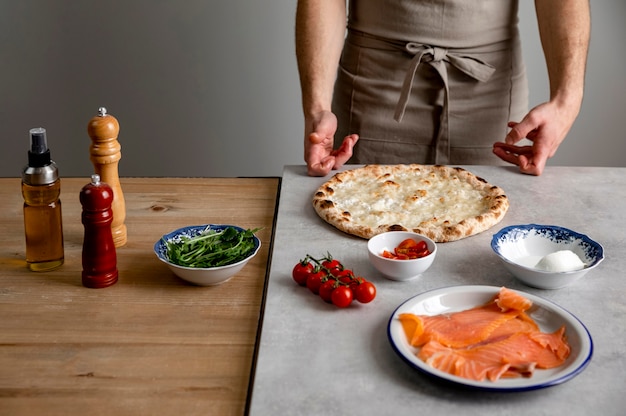(Part 1) Salmon 101: Understanding Your Fish

A Quick Look at Salmon Varieties
atlantic salmon: This is the most common type you'll find in supermarkets, and it's a great choice for everyday cooking. It has a firm texture and a mild, slightly sweet flavor. sockeye salmon: This is a real treat! It has a richer flavor and a deep orange color thanks to its diet of shrimp and krill. The flavor is more intense and slightly richer than Atlantic salmon. chinook salmon: Also known as King Salmon, this is the largest of the pacific salmon species and is known for its rich, buttery texture and intense flavor. It's often considered the best salmon variety for grilling or baking. coho salmon: Also known as Silver Salmon, this is a great option for baking or grilling. It has a slightly more delicate flavor than Chinook but is still very tasty. pink salmon: This is a more affordable option with a slightly milder flavor than other varieties. It's perfect for canning, smoking, or using in salads.Deciphering the salmon cuts
Fillets: The most common cut, usually boneless and skinless, perfect for quick cooking methods like pan-searing or baking. Steaks: These cuts are thicker and have the skin on, ideal for grilling or baking. Whole Salmon: This is the whole fish, great for roasting or smoking. It's a bit more challenging to cook but yields a beautiful presentation.(Part 2) The Salmon Cooking Time Game

It’s All About Thickness
The biggest factor when it comes to salmon cooking time is the thickness of the fillet or steak. A thin fillet will cook much faster than a thick steak. Think of it like baking a cake – a smaller cake will bake faster than a larger one.Understanding “Doneness”
Let's be honest, the whole "internal temperature" thing can be a bit confusing, and frankly, I find it less reliable than other methods. Here's how I gauge doneness: Color: The flesh should be opaque, not translucent, and have a lovely pink color. It might have a hint of white at the center if it's cooked a bit more. Texture: The fish should be firm to the touch and flake easily when gently prodded with a fork. Skin: If you're cooking skin-on salmon, the skin should be crispy and easily peel away.(Part 3) salmon cooking methods: A Journey of Flavour

Pan-Seared salmon: A Quick and Delicious Option
Pan-searing is my go-to for a simple and tasty dinner. It creates a beautiful crispy crust and keeps the inside juicy and tender.
Cooking time: For a 1-inch thick fillet, it’ll take about 3-4 minutes per side, depending on the heat of your pan. Tips: Use a heavy-bottomed pan and heat it over medium-high heat. Pat the salmon dry and season generously. Don't overcrowd the pan, cook the fillets in batches if needed. Doneness: The salmon should have a golden brown crust and the flesh should be cooked through, but still moist and flaky.baked salmon: Easy and Effortless
Cooking time: For a 1-inch thick fillet, it’ll take about 12-15 minutes at 400°F (200°C). Tips: Place the salmon on a baking sheet lined with parchment paper, drizzle with olive oil, and season to your taste. You can add vegetables like asparagus or broccoli for a complete meal. Doneness: The salmon should be cooked through and slightly flaky, but not dry.grilled salmon: Summertime Delight
Grilling salmon brings out a wonderful smoky flavor and creates those beautiful grill marks. It's a perfect summer dish.
Cooking time: For a 1-inch thick fillet, it’ll take about 4-6 minutes per side over medium heat. Tips: Use a gas or charcoal grill. Oil the grill grates to prevent sticking. Doneness: The salmon should have grill marks and be cooked through, but still moist and flaky.poached salmon: Gentle and Delicate
Cooking time: For a 1-inch thick fillet, it’ll take about 5-7 minutes in simmering poaching liquid. Tips: Poach the salmon in a mixture of water, wine, and herbs. This method produces a delicate and flavorful salmon. Doneness: The salmon should be cooked through and tender, with a delicate texture.sous vide salmon: Precise and Consistent Results
Sous Vide is a great option for ensuring perfectly cooked salmon every time. It's a bit more involved, but it's worth it for the consistent results.
Cooking time: For a 1-inch thick fillet, it’ll take about 15-20 minutes at 125°F (52°C). Tips: Vacuum seal the salmon with a bit of olive oil, salt, and pepper. Place in a water bath for the specified time. Doneness: The salmon will be perfectly cooked through and tender, with a consistent texture throughout.(Part 4) The Art of Resting Salmon: A Crucial Step
Okay, your salmon is cooked! But before you dive in, there's one crucial step – resting. It might sound like an extra chore, but it's essential for locking in moisture and allowing the flavors to meld.Let the salmon rest for 5-10 minutes on a cutting board before slicing and serving. This will give the juices time to redistribute throughout the fish, resulting in a beautifully moist and tender piece of salmon. Think of it as a little time-out for your fish to relax after its culinary adventure.
(Part 5) Mastering the Salmon Cooking Chart
I know how confusing all these cooking times can be. So, I've put together a handy table to help you navigate the salmon cooking time waters.Here’s a quick guide for different cooking methods and thickness:
| Cooking Method | Thickness (inches) | Cooking Time (minutes) |
|---|---|---|
| Pan-Seared | 1/2 | 2-3 per side |
| 1 | 3-4 per side | |
| 1 1/2 | 4-5 per side | |
| Baked | 1/2 | 10-12 |
| 1 | 12-15 | |
| 1 1/2 | 15-18 | |
| Grilled | 1/2 | 3-4 per side |
| 1 | 4-6 per side | |
| 1 1/2 | 5-7 per side | |
| Poached | 1/2 | 4-5 |
| 1 | 5-7 | |
| 1 1/2 | 7-9 | |
| Sous Vide | 1/2 | 12-15 |
| 1 | 15-20 | |
| 1 1/2 | 20-25 |
Remember, these are just guidelines. Always check for doneness using the visual cues we talked about earlier. You'll soon be able to tell when your salmon is perfectly cooked, just like an experienced chef.
(Part 6) Salmon cooking tips: From a Fellow Salmon Enthusiast
Over the years, I've picked up a few tricks and tips for making sure my salmon turns out perfectly every time. Here are some of my favorites:Seasoning Secrets
Salt and Pepper: A classic combo that always works well. Citrus Zest: Lemon, lime, or orange zest adds a bright and fresh flavor. Herbs: Fresh herbs like dill, parsley, chives, and thyme complement salmon beautifully. Spices: Experiment with spices like cumin, paprika, or garlic powder for a more complex flavor profile.Glaze and Sauce Ideas
Honey-Soy Glaze: A sweet and savory glaze that adds a delicious touch. Lemon-Herb Butter: A simple but effective way to enhance the flavor of salmon. Garlic-Dill Sauce: A classic pairing for salmon that never fails to impress. Salsa Verde: A vibrant and tangy sauce that adds a touch of zest.Storage and Prep
Refrigerate: Store salmon in the refrigerator until ready to use. Pat Dry: Before cooking, pat the salmon dry with paper towels to ensure a crispy crust. Don’t Overcrowd: Don't overcrowd the pan or baking sheet when cooking salmon, as this will result in steaming rather than searing.(Part 7) Salmon cooking mistakes: Learn from My Mishaps
Now, we all have our culinary mishaps, right? I've definitely had my fair share with salmon. Overcooked salmon, anyone? But fret not, I've learned from my mistakes and hopefully, you can learn from mine!The Dry Salmon Dilemma
Overcooked salmon is a common mistake, usually the result of not watching the cooking time closely. It's so important to check for doneness using those visual cues.Salmon Sticking Saga
Another common mistake is sticking. Make sure your pan is well-oiled, and don't overcrowd it. And if you're grilling, don't forget to oil the grill grates!The "Raw in the Middle" Issue
This is a common problem with thicker cuts of salmon. Be sure to cook it for a bit longer than thinner fillets, and check for doneness with a fork or thermometer.(Part 8) salmon leftovers: Don’t Waste Them!
We've all been there. You've cooked a delicious salmon dinner, but you've got leftovers. Now what? Don't throw them away! leftover salmon is a delicious and versatile ingredient that can be used in many different ways.Leftover Salmon Ideas
Salmon Salad: Flake leftover salmon into a salad with greens, veggies, and a light dressing. Salmon Sandwiches: Make a simple and tasty sandwich with leftover salmon, a little mayo, and some crunchy lettuce. Salmon Pasta: Add leftover salmon to your favourite pasta dish for a quick and easy meal. Salmon Soup: Use leftover salmon in a creamy or broth-based soup. Salmon fried rice: Combine leftover salmon with rice, vegetables, and your favorite sauce for a flavorful and satisfying meal. Salmon Quesadillas: Flake leftover salmon into a quesadilla with cheese and your favorite fillings.(Part 9) FAQs: Your Salmon Questions Answered
Let’s be honest, we all have questions. And when it comes to salmon, there’s a lot to ponder! Here are some common questions about salmon cooking times and techniques, and my answers, of course!Q1. What’s the Best Temperature for baking salmon?
A: I find that 400°F (200°C) is a great temperature for baking salmon. It cooks quickly and evenly, resulting in a moist and flaky fish.Q2. Can You Overcook Salmon in the Oven?
A: Yes, you can overcook salmon in the oven, which can make it dry and tough. It's important to keep a close eye on the cooking time and use the visual cues we talked about earlier.Q3. What’s the Best Way to Know When Salmon is Cooked?
A: I rely on visual cues to judge salmon doneness. The flesh should be opaque, not translucent, and the fish should be firm to the touch and flake easily when gently prodded with a fork. You can also use a meat thermometer to check the internal temperature, which should be 125°F (52°C).Q4. Can You Cook salmon skin-Side Down?
A: Yes, you can cook salmon skin-side down. In fact, it's often recommended, as it helps to create a crispy skin.Q5. How Do You Stop Salmon from Sticking to the Pan?
A: The key is to use a heavy-bottomed pan, heat it well, and pat the salmon dry before cooking. Don’t overcrowd the pan, and use a good quality oil.Q6. What is the best way to store salmon?
A: The best way to store salmon is in the refrigerator, wrapped tightly in plastic wrap or aluminum foil. You can also store it in an airtight container. It should be stored for no more than two days.Q7. Can you freeze salmon?
A: Yes, you can freeze salmon. To freeze salmon, wrap it tightly in plastic wrap or aluminum foil, then place it in a freezer-safe bag. It can be frozen for up to 3 months. When you're ready to use it, thaw it in the refrigerator overnight.Q8. What are some good side dishes for salmon?
A: Salmon pairs well with many side dishes, including: Roasted vegetables like asparagus, broccoli, or Brussels sprouts Green salads with a light vinaigrette dressing Creamy mashed potatoes Wild rice pilaf QuinoaAnd that's it! I hope this guide has given you the confidence to cook delicious salmon every time. Happy cooking!Everyone is watching

How to Cook Frozen Lobster Tails Perfectly: A Step-by-Step Guide
RecipesLobster. Just the word conjures up images of lavish meals, special occasions, and a taste of luxury. But let's...

Pigs in a Blanket Cooking Time: How Long to Bake for Perfect Results
RecipesAh, pigs in a blanket. Just the name conjures up images of those delightful little parcels of crispy pastry en...

Pork Fillet Cooking Time: How Long to Cook It Perfectly
RecipesPork fillet, or tenderloin as it's sometimes called, is a real favourite in our house. It's so versatile, and...

The Ultimate Guide to Tender, Juicy Pulled Pork
RecipesRight, let's talk pulled pork. It's one of those dishes that just screams "comfort food," doesn't it? I mean...

The Ultimate Guide to Cooking Sweet Potatoes: From Roasting to Mashing
RecipesSweet potatoes. Just the name conjures up images of warm, comforting dishes, bursts of vibrant color, and a to...
